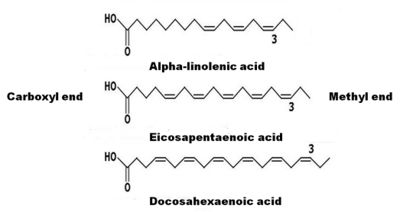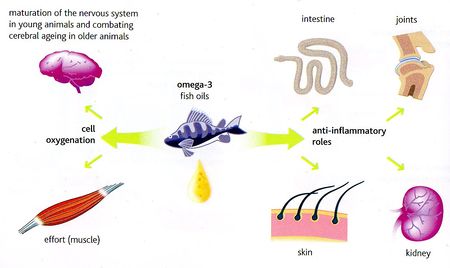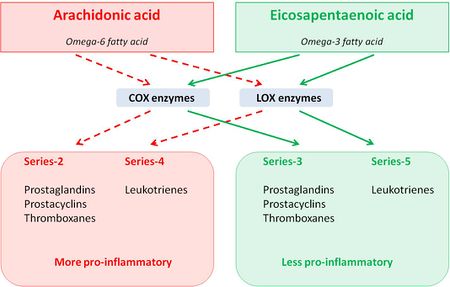What are Omega-3 Fatty Acids?
Omega-3 fatty acids are a family of polyunsaturated straight-chain hydrocarbons that have a double bond in the third carbon-carbon bond (n-3) when counted from the methyl end of the molecule. Only plants have the ability to add double bonds in the n-3 position. There is speculation that fatty acids belonging to the n-3 family, specifically alpha-linolenic acid and docosahexaenoic acid, exhibit essential fatty acid activity in dogs and cats.
Alpha-linolenic acid (ALA) is an 18 carbon chain with double bonds at the n-3, n-6 and n-9 positions (written as 18:3n-3) that accumulated in skin phospholipids;[1] docosahexaenoic acid (DHA) is a 22 carbon chain with doubles bonds at the n-3, n-6, n-9, n-12, n-15, and n-18 positions (written as 18:6n-3) that accumulates in the retina during growth and development.[2] Alpha-linolenic acid undergoes an initial desaturation by hepatic Δ-6 desaturase followed by elongation and another desaturation to form eicosapentaenoic acid (EPA; 20:5n-3).[3] Dogs have the ability to convert modest amounts of ALA to EPA and supplementing with dietary ALA has been shown to increase plasma EPA levels in dogs;[4] cats are unlikely to synthesise significant amounts of EPA from ALA given their limited hepatic Δ-6 desaturase enzyme activity.[5] Eicosapentaenoic acid is further elongated to form docosapentaenoic acid (DPA), which is released into circulation and taken up by the retina and brain where it is converted to docosahexaenoic acid (DHA).[6],[7]
Why are they Important?
Alpha-linolenic acid works in conjunction with linoleic acid (LA) to help maintain skin and hair coat quality;[8] EPA is incorporated into the lipid bilayer of cell membranes along with arachidonic acid (AA) and may dampen inflammatory reactions;[9] DHA is conditionally essential for normal brain and retinal development in puppies and kittens.[2][10][11]
Omega-6 and omega-3 fatty acids are in competition for the same metabolic enzymes and the ratio of omega-6 to omega-3 fatty acids as well as the total amount of each polyunsaturated fatty acid is an important consideration when evaluating dietary balance or when attempting to modify concentrations of these nutrients for health and disease management.
Roles in the Body
- Skin and Hair Coat: Epidermal keratinocytes secrete the LA-enriched phospholipid, ceramide, in both dogs and cats, which enhances cell cohesion and creates an effective water barrier.[12] Increased intake of ALA may blunt the conversion of LA to AA,[1][4] allowing for more LA to be incorporated into ceramide. Ratios of LA:ALA of 2.6:1 to 26:1 have been proposed for optimal skin and coat health.[13]
- Inflammation: Eicosapentaenoic acid is incorporated into cellular membrane and competes with AA for cyclooxygenase (COX) and lipoxygenase (LOX) enzymes. Inflammatory eicosanoids produced from EPA (series-3 prostaglandins, prostacyclins and thromboxanes and series-5 leukotrienes) are less pro-inflammatory than those produced from AA metabolism.[13] Though not considered an essential fatty acid, increased intake of EPA in conjunction with a decrease in AA intake has been suggested as an aid in the management of inflammatory conditions such as allergic dermatitis,[14] nephritis,[15] and osteoarthritis[16] in dogs. Supplementation of EPA has also been shown to be beneficial in older healthy dogs[17][18] as well as those with heart disease.[19] Supplementation with higher levels of EPA in people undergoing cancer treatment may also result in a decrease in circulating IL-6 levels and improvement in lean body mass and appetite[20][21]. This specific effect of EPA on lean body mass and appetite has not been studied in dogs and cats, but EPA supplementation may be beneficial to help decrease inflammation secondary to radiation therapy in dogs with nasal tumours.[22] Additionally, dogs with lymphoma (stage 3a) had an improvement in short-term survival when fed a diet supplemented with EPA and DHA among other nutrient modifications[23]. These effects have not been demonstrated in cats or in dogs with other types of cancers.
- Growth: Docosapentaenoic acid is taken up by brain and retinal tissues where it is converted to DHA. Docosahexaenoic acid is incorporated into retinal rods and brain tissue,[2][10] and is conditionally essential for normal brain and retinal development.
Consequences of Omega-3 Deficiency
- Growth: Puppies fed DHA deficient diets will grow normally, but show poor response to learned behaviour and visual acuity tests compared with puppies fed diets enriched with DHA.[2][10] Kittens fed DHA deficient diets during gestation and lactation also have poor retinal and visual development.[11]
- Adult Maintenance: Clinical signs of ALA deficiency in adult dogs and cats are similar to LA deficiency (i.e. seborrheic dermatitis), but are relatively mild and easy to miss.[13]
Toxicity
Excess intake of ALA without a concurrent increase in LA resulting in a ratio below 2.6:1 (LA:ALA) may interfere with LA uptake into ceramide and the conversion of LA to AA,[2] but toxicity studies are lacking.
Excess EPA intake can cause platelet abnormalities and bleeding disorders in cats,[24] though this effect has not been demonstrated in dogs[25]. Dogs fed excessive amounts of the omega-3 long-chain polyunsaturated fatty acids, EPA and DHA, have shown impaired wound healing[26][27] as well as impaired cellular immunity.[28]
Dietary Sources
Specific seed and seed oils have varying concentrations of ALA; for example flaxseed oil provides 50% of the total fat as ALA while rapeseed (i.e. canola oil) provides 20% ALA[29]. Terrestrial animal fats (associated with muscle, organ meat, eggs) are poor sources of ALA. Cold-water algae produce high concentrations of DHA, which is converted to EPA by marine fish after consumption; there is variation in EPA concentration between wild and farmed fish species. Recommendations for optimal ratios of omega-6 to omega-3 fatty acids are provided to pet food manufacturers, but an optimal amount of ALA has not been determined. Diets with higher levels of polyunsaturated fat (ALA, EPA and DHA) are prone to oxidative damage and require larger concentrations of dietary antioxidants to prevent rancidity (fat oxidation) during processing and storage.
Diagnosing Omega-3 Fatty Acid Deficiency
Diagnosis of ALA and DHA deficiency is difficult to make clinically and evaluation of diet is often used to demonstrate inadequate intake. Plasma lipid profiles may show low circulating concentrations of ALA and DPA though normal reference intervals have not been established.
References
- ↑ 1.0 1.1 Rees CA, et al. (2001) Effects of dietary flax seed and sunflower seed supplementation on normal canine serum polyunsaturated fatty acids and skin and hair coat condition scores. Vet Dermatol;12:111-117.
- ↑ 2.0 2.1 2.2 2.3 2.4 Zicker SC, et al. (2012) Evaluation of cognitive learning, memory, psychomotor, immunologic, and retinal functions in healthy puppies fed foods fortified with docosahexaenoic acid–rich fish oil from 8 to 52 weeks of age. JAVMA 2012;241:583-594.
- ↑ Dunbar BL and Bauer JE. (2000) Conversion of essential fatty acids by delta-6 desaturase enzyme in dog liver microsomes. J Nutr 2000;132:1701S-1703S.
- ↑ 4.0 4.1 Bauer JE, et al. (1998) Dietary Flaxseed in Dogs Results in Differential Transport and Metabolism of (n-3) Polyunsaturated Fatty Acids. J Nutr 1998;128:2641S-2644S.
- ↑ Sinclair AJ, et al. (1981) Essential fatty acid deficiency and evidence for arachidonate synthesis in the cat. Br J Nutr 1981;46:93-93.
- ↑ Alvarez RA, et al. (1994) Docosapentaenoic acid is converted to docosahexaenoic acid in the retinas of normal and pred-affected miniature poodles. Inv Ophthal Vis Sci 1994;35:402-408.
- ↑ Pawlosky R, et al. (1994) Essential fatty acid metabolism in the feline: relationship between liver and brain production of long-chain polyunsaturated fatty acids. J Lip Res 1994;35:2032-2040.
- ↑ Bauer JE. (2007) Responses of dogs to dietary omega-3 fatty acids. JAVMA 2007;231:1657-1661.
- ↑ Raphael W and Sordillo LM. (2013) Dietary Polyunsaturated Fatty Acids and Inflammation: The Role of Phospholipid Biosynthesis. Int J Mol Sci 2013;14:21167-21188.
- ↑ 10.0 10.1 10.2 Heinemann KM and Bauer JE. (2005) Docosahexaenoic acid and neurologic development in animals JAVMA 2005;228:700-705.
- ↑ 11.0 11.1 Pawlosky R, et al. (1997) Retinal and brain accretion of long-chain polyunsaturated fatty acids in developing felines: the effect of corn-based maternal diets. Am J Clin Nutr 1997;65:465-472.
- ↑ Elias PM, et al. (1980) The permeability barrier in essential fatty acid deficiency: Evidence for a direct role of linoleic acid in barrier function. J Invest Dermatol 1980;74:230-233.
- ↑ 13.0 13.1 13.2 National Research Council (NRC). (2006) Fat and Fatty Acids In Nutrient Requirements for Dogs and Cats. 2006 Washington, DC: National Academies Press p.81-110.
- ↑ Mueller RS, et al. (2005) Plasma and skin concentrations of polyunsaturated fatty acids before and after supplementation with n-3 fatty acids in dogs with atopic dermatitis. Am J Vet Res 2005;66:868-73.
- ↑ Brown SA, et al. (2000) Effects of dietary polyunsaturated fatty acid supplementation in early renal insufficiency in dogs. J Lab Clin Med 2000;135:275-286.
- ↑ Roush JK, et al. (2010) Multicenter veterinary practice assessment of the effects of omega-3 fatty acids on osteoarthritis in dogs. JAVMA 2010;236:59-66.
- ↑ Hall JA, et al. (1999) Effect of dietary n-6 to n-3 ratio on complete blood and total white cell counts, and T cell populations in aged dogs. AJVR 1999;60:319-327.
- ↑ Hall JA, et al. (1999) Influence of dietary long-chain n-3 fatty acids from menhaden fish oil on plasma concentrations of α-tocopherol in geriatric beagles. AJVR 1999;63:104-110.
- ↑ Freeman LM, et al. (1998) Nutritional alterations and the effect of fish oil supplementation in dogs with heart failure. JVIM 1998;12:440-448.
- ↑ Barber MD, et al. (2001) Effect of a fish oil-enriched nutritional supplement on metabolic mediators in patients with pancreatic cancer cachexia. Nutr Cancer 2001;40:118-24.
- ↑ Fearon KC, et al. (2003) Effect of a protein and energy dense N-3 fatty acid enriched oral supplement on loss of weight and lean tissue in cancer cachexia: a randomised double blind trial. Gut 2003;52:1479-86.
- ↑ Hansen RA, et al. (2011) Menhaden oil administration to dogs treated with radiation for nasal tumors demonstrates lower levels of tissue eicosanoids. Nutr Res 2011;31:929-36.
- ↑ Ogilvie GK, et al. (2000) Effect of fish oil, arginine, and doxorubicin chemotherapy on remission and survival time for dogs with lymphoma: a double-blind, randomized placebo-controlled study. Cancer 2000;88:1916-28.
- ↑ Saker KE, et al. (1998) Manipulation of dietary (n-6) and (n-3) ratio fatty acids alters platelet function in cats. J Nutr 1998;128:2845S-2647S
- ↑ Boudreaux ML, et al. (1997) The effects of varying dietary n-6 to n-3 fatty acids ratios on platelet reactivity, coagulation screening assays, and antithrombin II activity in dogs. JAAHA 1997;33:235-243.
- ↑ Mooney MA, et al. (1998) Evaluation of the effects of omega-3 fatty acid containing diets on the inflammatory stage of wound healing in dogs. AJVR 1998;59:859-863.
- ↑ Scardino MS, et al. (1999) The effects of omega-3 fatty acid diet enrichment on wound healing. Vet Derm 1999;10:283-290.
- ↑ Wander RC, et al. (1997) The ratio of dietary (n-6) to (n-3) fatty acids influences immune system function, eicosanoid metabolism, lipid peroxidation and vitamin E status in aged dogs. J Nutr 1997;127:1198-1205.
- ↑ USDA Nutrient Database. http://ndb.nal.usda.gov/ndb/ (accessed April 2015)
| This article was: Date reviewed: 19 May 2015 |
| Endorsed by WALTHAM®, a leading authority in companion animal nutrition and wellbeing for over 50 years and the science institute for Mars Petcare. |
Error in widget FBRecommend: unable to write file /var/www/wikivet.net/extensions/Widgets/compiled_templates/wrt695b597b9dbb46_81952126 Error in widget google+: unable to write file /var/www/wikivet.net/extensions/Widgets/compiled_templates/wrt695b597baf1154_63927551 Error in widget TwitterTweet: unable to write file /var/www/wikivet.net/extensions/Widgets/compiled_templates/wrt695b597bb7b217_40463337
|
| WikiVet® Introduction - Help WikiVet - Report a Problem |


